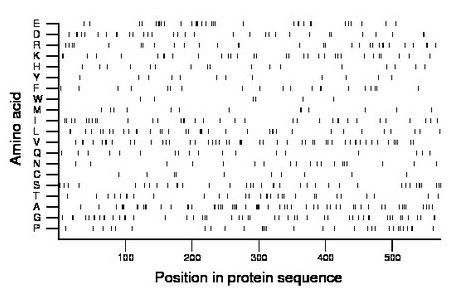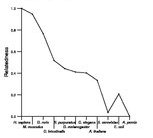
| Name: DPYSL4 | Sequence: fasta or formatted (572aa) | NCBI GI: 190194363 | |
|
Description: dihydropyrimidinase-like 4
|
Referenced in: Pyrimidine Biosynthesis and Catabolism
| ||
|
Composition:

Amino acid Percentage Count Longest homopolymer A alanine 10.1 58 3 C cysteine 1.9 11 2 D aspartate 5.6 32 2 E glutamate 5.8 33 3 F phenylalanine 3.5 20 1 G glycine 8.7 50 2 H histidine 3.0 17 1 I isoleucine 5.9 34 2 K lysine 5.6 32 2 L leucine 6.5 37 2 M methionine 2.4 14 1 N asparagine 3.3 19 1 P proline 5.4 31 2 Q glutamine 3.1 18 1 R arginine 5.2 30 2 S serine 6.5 37 2 T threonine 5.4 31 2 V valine 8.7 50 3 W tryptophan 1.0 6 1 Y tyrosine 2.1 12 1 |
Comparative genomics:
Search single species RefSeq proteins at NCBI
Search summary 
Figure data | ||
Related human proteins:Protein Relative score Description Self-match 1.000 dihydropyrimidinase-like 4 DPYSL2 0.782 dihydropyrimidinase-like 2 DPYSL3 0.729 dihydropyrimidinase-like 3 CRMP1 0.718 collapsin response mediator protein 1 isoform 2 [Homo... CRMP1 0.699 collapsin response mediator protein 1 isoform 1 [Hom... DPYS 0.512 dihydropyrimidinase DPYSL5 0.480 dihydropyrimidinase-like 5 CAD 0.028 carbamoylphosphate synthetase 2/aspartate transcarba... CHST11 0.005 carbohydrate sulfotransferase 11 LOC100294335 0.005 PREDICTED: similar to c114 SLIT-like testicular pro... LOC100294335 0.005 PREDICTED: similar to c114 SLIT-like testicular pro... LIN7B 0.005 lin-7 homolog B LRRC37A2 0.005 c114 SLIT-like testicular protein LRRC37A3 0.005 leucine rich repeat containing 37, member A3 MYSM1 0.004 Myb-like, SWIRM and MPN domains 1 LRRC37A 0.004 leucine rich repeat containing 37A LIN7C 0.004 lin-7 homolog C KHDRBS1 0.004 KH domain containing, RNA binding, signal transductio... KY 0.004 kyphoscoliosis peptidaseHuman BLASTP results (used to prepare the table) | |||
Gene descriptions are from NCBI RefSeq. Search results were obtained with NCBI BLAST and RefSeq entries. When identical proteins are present, the self-match may not be listed first in BLASTP output. In such cases, the table above has been reordered to place it first.
See About the Figures for the scoring system used in the figure above right. The same scoring system was used in the table of BLASTP results.
Guide to the Human Genome
Copyright © 2010 by Stewart Scherer. All rights reserved.
